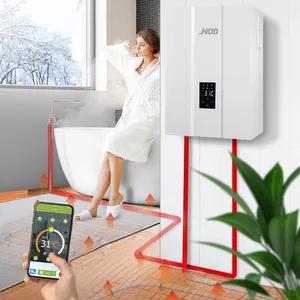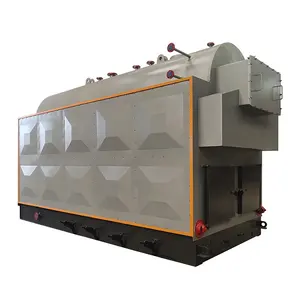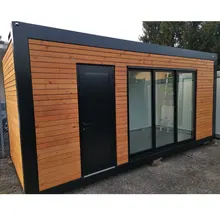The wood pellet boiler is an advanced heating solution that harnesses the energy of biomass pellets to deliver a sustainable and cost-efficient source of warmth. As businesses increasingly prioritize ecological considerations, a wood pellet furnace boiler signifies more than a mere heating investment; it embodies a pledge to environmental responsibility and energy conservation.
Types and Characteristics of Wood Pellet Boilers
Among the spectrum of wood pellet boilers, a variety of models exist, each with distinct features. The outdoor pellet boiler, for example, is engineered to endure the rigors of the outdoors, making it suitable for enterprises with exterior space. Conversely, wood pellet stoves with back boiler serve a dual function, offering both ambient warmth and hot water, an ideal choice for smaller establishments like boutique hotels or office environments. For more demanding settings such as industrial sites or agricultural operations, industrial machinery wood pellet boilers provide greater capacity and durability. Each variant is designed to meet specific commercial requirements, ensuring a fitting wood pellet boiler solution for any context. Moreover, the pellet stove with back boiler is an exemplary option for businesses in search of a compact system that delivers both heating and hot water, while the wood chip burner caters to those with a supply of wood chips for fuel.
Structure and Operation of Wood Pellet Boilers
The architecture of a wood pellet biomass boiler is a testament to engineering ingenuity, optimized for peak efficiency and user-friendliness. Central to the system is the combustion chamber, where wood pellets are incinerated. This chamber is linked to a heat exchanger that conveys the generated warmth to water, producing steam or hot water for heating. The operation encompasses essential components such as an auger for pellet transport from the storage hopper to the burner, sensors for combustion regulation, and a control panel that facilitates temperature and schedule adjustments. The synergy of these elements guarantees smooth functioning and consistent thermal output. Additionally, the boilers may incorporate sophisticated features like modulating burners that adapt flame intensity to match heat demand, further improving efficiency and fuel savings.
Materials and Benefits
The selection of materials for a wood pellet furnace boiler is pivotal to its efficacy and lifespan. Premium stainless steel is commonly employed in critical parts to prevent corrosion and endure high temperatures. Cast iron components ensure resilience and heat retention, while advanced ceramics are utilized in insulation to preserve thermal efficiency. The advantages of these materials are numerous; they not only bolster the boiler's performance but also extend its operational life, minimizing the frequency of replacements and maintenance. The employment of alumina ceramics, for instance, provides exceptional thermal constancy and resistance to thermal shock, essential in the boiler's high-temperature milieu.
Business Usages and Applications
The deployment of wood pellet furnaces spans a broad range of industries. In construction, they offer a green heating alternative for new edifices. Retail environments benefit from the inviting warmth they generate, potentially enhancing the shopping experience. Within the hospitality sector, they provide guests with cozy accommodations without the environmental toll of conventional heating methods. Their adoption in educational and healthcare facilities reflects a dedication to sustainability while managing costs. The economic value of these boilers is evident in diminished energy expenditures, bolstered public image, and adherence to tightening environmental regulations. In agriculture, they can be utilized for crop drying and greenhouse heating, demonstrating their versatility and adaptability to diverse commercial needs.
Functions and Tasks
A pellet boiler is engineered to perform the primary role of heating spaces efficiently. It can be integrated into pre-existing heating networks or operate independently. Its specific duties encompass providing central heating, domestic hot water, and occasionally powering heat-dependent industrial processes. The adaptability of these boilers enables them to fit into various contexts, from ensuring a cozy ambiance in intimate eateries to sustaining optimal temperatures in expansive greenhouses. The automation of pellet feeding and combustion means the boiler demands minimal user involvement, permitting business proprietors to concentrate on their principal operations without heating system concerns.
Features and Unique Selling Points
Notable attributes of a wood pellet boiler stove include automated systems for pellet feeding, self-cleaning mechanisms, and advanced control panels that support remote operation. These features distinguish them from traditional heating systems and other renewable alternatives. The unique selling proposition of these boilers lies in their amalgamation of eco-friendliness, ease of use, and technological advancement, presenting a compelling case for businesses contemplating heating upgrades. For example, the pellet burner for boiler systems often boasts a self-ignition function, simplifying the start-up to a mere button press.
Benefits and Positive Outcomes
The advantages of investing in a wood chip boiler go beyond heating efficacy. They significantly curtail carbon footprints, aligning with corporate environmental objectives. Users also experience a cleaner burn, with reduced soot and ash compared to conventional wood-fueled options. The automated nature of these systems translates to decreased manual labor, saving time and reducing labor costs. For businesses, this equates to a cleaner, greener, and more economical heating solution. The boilers' compatibility with various biomass fuels also allows businesses to select the most affordable and locally sourced option, further cutting operational expenses and bolstering local economies.
Usage, Maintenance, and Installation Guidelines
Optimal functioning of a wood pellet furnace boiler begins with selecting the appropriate model. Considerations should include heating requirements, available space for the boiler and pellet storage, and proximity to pellet suppliers. Post-installation, boiler operation is straightforward, with many models featuring touch-screen controls and customizable settings. Routine maintenance entails ash disposal and periodic cleaning of the heat exchanger and burner, facilitated by easily accessible panels. Professional installation is paramount to ensure safety compliance and peak performance. It is also crucial to verify proper flue installation and sufficient ventilation to avert combustion gas complications.
How do I choose the right wood pellet boiler for my business?
...
What are the environmental impacts of using a wood pellet boiler?
...
Are there any specific considerations for installing a wood pellet boiler?
...











































 浙公网安备 33010002000092号
浙公网安备 33010002000092号 浙B2-20120091-4
浙B2-20120091-4